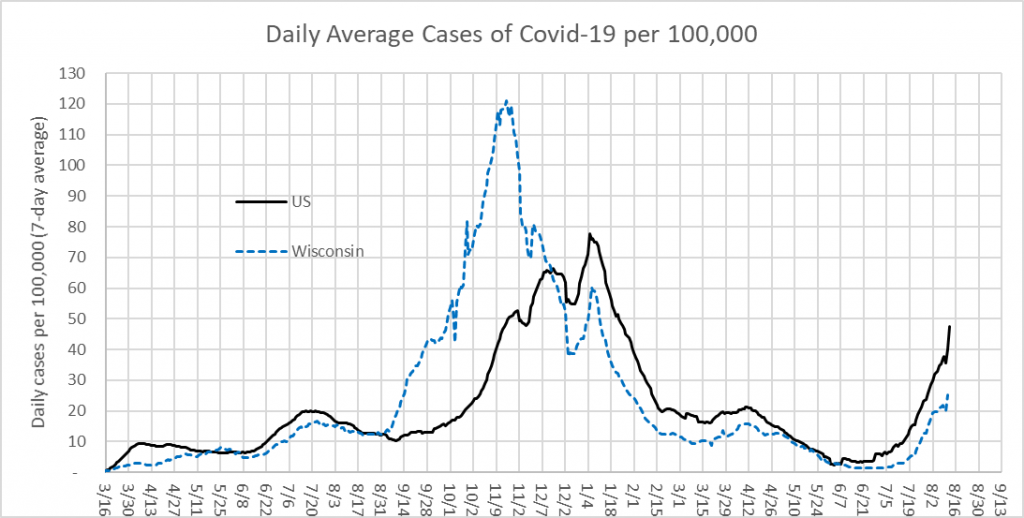Most Republican Voters Want The Vaccine
Only a hard-core minority oppose it. So why are GOP politicians encouraging this, and risking our health?
The Marquette Law School Poll of Wisconsin voters taken August 3-8 asked two questions about vaccinations. The first asked whether the voter had at least one vaccine dose. The second asked those who had received no vaccine whether they expected to get vaccinated.
I combined the two questions, adding those who said they would definitely or probably get the vaccine to those that already had been vaccinated, leaving those who said they had not received the vaccine and definitely or probably would not get it.
Opposition to the vaccine enjoys the support of a minority of a minority. It seems puzzling, therefore, that so many Republican politicians, including the governors of Florida and Texas — and the Wisconsin Republican legislators — are willing to be flag bearers in opposition to measures aimed at limiting the spread of COVID-19.
Ideology turned out to be an even stronger predictor of vaccine support than partisanship. The next chart show the relationship between self-described ideology and vaccine support. Only among those identifying as “very conservative,” did a majority reject the vaccine.
Partisanship and ideology were the only subgroupings to show this sharp distinction with vaccine hesitancy. For example, the five geographical divisions reported by Marquette ranged only between 75% vaccine support (for the state beyond Milwaukee, Madison, and the Fox Valley and 85% (for the Madison area). Similarly, support from demographic groups ranged from 71% (for Blacks) to 87% (Hispanics), with whites in the middle (79%).
Since there are no national standards there is considerable variation in the way data are reported. Whatever the problems with the available data, they do point to vaccine success in preventing cases, hospitalizations, and deaths. The next graph shows four measures of success, using both the average of the reporting states and data from California. Far more cases appear among unvaccinated populations:
- Only one per thousand of currently vaccinated people has been infected by Covid so far.
- During this period vaccinated people were only 1% to 2% of Covid cases.
- Similarly, vaccinated people made up less than 2% of those who had to be hospitalized.
- Finally, they represent less than 2% of the deaths from Covid.
Clearly, the vaccines work at preventing COVID-19 cases, hospitalizations, and deaths, but only if people decide to get vaccinated. The next chart compares the number of new cases of Covid per day in Wisconsin (the blue dashed line) and nationally (in black). For comparability, the number of cases was converted to the number of cases per 100,000 people.
In late June and early July, it appeared that Covid was on the run. Businesses that had closed or had restrictions opened and removed those restrictions. My local coffee shop reopened with the staff masked, and then dropped the masks. Recently, the staff are wearing masks again along with a sign: “We highly encourage masks be worn to prevent spread of Covid-19.” Currently Wisconsin is doing better than the nation but suffers from the same uptick as other states.
Florida and Texas are two states whose governors are infamous for fighting steps to control the virus, particularly the wearing of masks and vaccinations. The graph below shows the result. with Florida in yellow and Texas in green. (Again, the numbers are adjusted for population.) Notably, Florida’s recent peak exceeds its peak last winter.
The trends are pointing towards another Covid crisis, leading to a need for another shutdown in the economy. The inescapable conclusion is the politicians who are most opposed to a future shutdown are most likely to make it necessary if they continue fighting masks and widespread vaccination. In Wisconsin, the proposed bill to make those who quit a job to avoid a vaccination requirement eligible for unemployment benefits is only the most recent example of such anti-vax efforts on the right.
It is sometimes argued that people who put themselves at risk by avoiding vaccinations have a right to do so, under the principal that people should be allowed to do dangerous things if they are the only ones that would pay the price. But unvaccinated people do cause health risks and costs for the larger society:
-
- By delaying herd immunity in which infections simply die out for lack of targets, they put at risk those who cannot get the vaccine, including children and people with compromised immune systems
- Even though the vaccines are very effective, they are not perfect. A large group of non-immunized people serves as a reservoir of infection that can cross over.
- The cost of their hospitalization is likely to be shifted to government or insurers
- A large reservoir of unvaccinated people serves the needs of the virus to constantly find new victims, raising the odds of more dangerous variants than the delta variant.
It is often argued that those choosing to be vaccinated should be kind to resistors. This strategy is not working. Only be raising the cost of refusing the vaccine—by making the vaccination a condition of employment or attending a performance—is the nation likely to reach herd immunity.
More about the Coronavirus Pandemic
- Governors Tony Evers, JB Pritzker, Tim Walz, and Gretchen Whitmer Issue a Joint Statement Concerning Reports that Donald Trump Gave Russian Dictator Putin American COVID-19 Supplies - Gov. Tony Evers - Oct 11th, 2024
- MHD Release: Milwaukee Health Department Launches COVID-19 Wastewater Testing Dashboard - City of Milwaukee Health Department - Jan 23rd, 2024
- Milwaukee County Announces New Policies Related to COVID-19 Pandemic - David Crowley - May 9th, 2023
- DHS Details End of Emergency COVID-19 Response - Wisconsin Department of Health Services - Apr 26th, 2023
- Milwaukee Health Department Announces Upcoming Changes to COVID-19 Services - City of Milwaukee Health Department - Mar 17th, 2023
- Fitzgerald Applauds Passage of COVID-19 Origin Act - U.S. Rep. Scott Fitzgerald - Mar 10th, 2023
- DHS Expands Free COVID-19 Testing Program - Wisconsin Department of Health Services - Feb 10th, 2023
- MKE County: COVID-19 Hospitalizations Rising - Graham Kilmer - Jan 16th, 2023
- Not Enough Getting Bivalent Booster Shots, State Health Officials Warn - Gaby Vinick - Dec 26th, 2022
- Nearly All Wisconsinites Age 6 Months and Older Now Eligible for Updated COVID-19 Vaccine - Wisconsin Department of Health Services - Dec 15th, 2022
Read more about Coronavirus Pandemic here
Data Wonk
-
Life Expectancy in Wisconsin vs. Other States
 Dec 10th, 2025 by Bruce Thompson
Dec 10th, 2025 by Bruce Thompson
-
How Republicans Opened the Door To Redistricting
 Nov 26th, 2025 by Bruce Thompson
Nov 26th, 2025 by Bruce Thompson
-
The Connection Between Life Expectancy, Poverty and Partisanship
 Nov 21st, 2025 by Bruce Thompson
Nov 21st, 2025 by Bruce Thompson




























30% of health care workers nationwide refuse to take the COVID vaccination.
WISN News article: August 19, 2021 – Some nurses willing to pay hefty price to not get COVID-19 vaccine
https://www.wisn.com/article/some-nurses-willing-to-pay-hefty-price-to-not-get-covid-19-vaccine/37343992